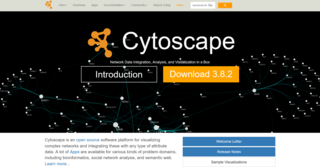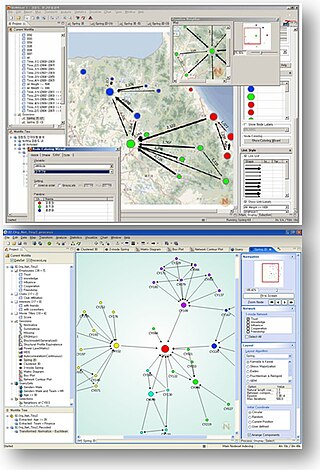| Filename extension | .gml |
|---|---|
| Internet media type | text/vnd.gml |
| Developed by | Michael Himsolt |
Graph Modeling Language (GML) is a hierarchical ASCII-based file format for describing graphs. It has been also named Graph Meta Language.
| Filename extension | .gml |
|---|---|
| Internet media type | text/vnd.gml |
| Developed by | Michael Himsolt |
Graph Modeling Language (GML) is a hierarchical ASCII-based file format for describing graphs. It has been also named Graph Meta Language.
A simple graph in GML format:
graph [ comment "This is a sample graph" directed 1 id 42 label "Hello, I am a graph" node [ id 1 label "node 1" thisIsASampleAttribute 42 ] node [ id 2 label "node 2" thisIsASampleAttribute 43 ] node [ id 3 label "node 3" thisIsASampleAttribute 44 ] edge [ source 1 target 2 label "Edge from node 1 to node 2" ] edge [ source 2 target 3 label "Edge from node 2 to node 3" ] edge [ source 3 target 1 label "Edge from node 3 to node 1" ] ]

Graph drawing is an area of mathematics and computer science combining methods from geometric graph theory and information visualization to derive two-dimensional depictions of graphs arising from applications such as social network analysis, cartography, linguistics, and bioinformatics.

In computing, a visual programming language, also known as diagrammatic programming, graphical programming or block coding, is a programming language that lets users create programs by manipulating program elements graphically rather than by specifying them textually. A VPL allows programming with visual expressions, spatial arrangements of text and graphic symbols, used either as elements of syntax or secondary notation. For example, many VPLs are based on the idea of "boxes and arrows", where boxes or other screen objects are treated as entities, connected by arrows, lines or arcs which represent relations. VPLs are generally the basis of Low-code development platforms.

Graphviz is a package of open-source tools initiated by AT&T Labs Research for drawing graphs specified in DOT language scripts having the file name extension "gv". It also provides libraries for software applications to use the tools. Graphviz is free software licensed under the Eclipse Public License.
DOT is a graph description language, developed as a part of the Graphviz project. DOT graphs are typically stored as files with the .gv or .dot filename extension — .gv is preferred, to avoid confusion with the .dot extension used by versions of Microsoft Word before 2007. dot is also the name of the main program to process DOT files in the Graphviz package.
GraphML is an XML-based file format for graphs. The GraphML file format results from the joint effort of the graph drawing community to define a common format for exchanging graph structure data. It uses an XML-based syntax and supports the entire range of possible graph structure constellations including directed, undirected, mixed graphs, hypergraphs, and application-specific attributes.

A call graph is a control-flow graph, which represents calling relationships between subroutines in a computer program. Each node represents a procedure and each edge (f, g) indicates that procedure f calls procedure g. Thus, a cycle in the graph indicates recursive procedure calls.
XGMML is an XML application based on GML which is used for graph description.

Cytoscape is an open source bioinformatics software platform for visualizing molecular interaction networks and integrating with gene expression profiles and other state data. Additional features are available as plugins. Plugins are available for network and molecular profiling analyses, new layouts, additional file format support and connection with databases and searching in large networks. Plugins may be developed using the Cytoscape open Java software architecture by anyone and plugin community development is encouraged. Cytoscape also has a JavaScript-centric sister project named Cytoscape.js that can be used to analyse and visualise graphs in JavaScript environments, like a browser.
Enthought, Inc. is a software company based in Austin, Texas, United States that develops scientific and analytic computing solutions using primarily the Python programming language. It is best known for the early development and maintenance of the SciPy library of mathematics, science, and engineering algorithms and for its Python for scientific computing distribution Enthought Canopy.

Simulation Open Framework Architecture (SOFA) is an open source framework primarily targeted at real-time physical simulation, with an emphasis on medical simulation.
A graph database (GDB) is a database that uses graph structures for semantic queries with nodes, edges, and properties to represent and store data. A key concept of the system is the graph. The graph relates the data items in the store to a collection of nodes and edges, the edges representing the relationships between the nodes. The relationships allow data in the store to be linked together directly and, in many cases, retrieved with one operation. Graph databases hold the relationships between data as a priority. Querying relationships is fast because they are perpetually stored in the database. Relationships can be intuitively visualized using graph databases, making them useful for heavily inter-connected data.

NetworkX is a Python library for studying graphs and networks. NetworkX is free software released under the BSD-new license.
graph-tool is a Python module for manipulation and statistical analysis of graphs. The core data structures and algorithms of graph-tool are implemented in C++, making extensive use of metaprogramming, based heavily on the Boost Graph Library. Many algorithms are implemented in parallel using OpenMP, which provides increased performance on multi-core architectures.

NetMiner is an application software for exploratory analysis and visualization of large network data based on SNA. It can be used for general research and teaching in social networks. This tool allows researchers to explore their network data visually and interactively, helps them to detect underlying patterns and structures of the network. It features data transformation, network analysis, statistics, visualization of network data, chart, and a programming language based on the Python script language. Also, it enables users to import unstructured text data(e.g. news, articles, tweets, etc.) and extract words and network from text data. In addition, NetMiner SNS Data Collector, an extension of NetMiner, can collect some social networking service(SNS) data with a few clicks.

NodeXL is a network analysis and visualization software package for Microsoft Excel 2007/2010/2013/2016. The package is similar to other network visualization tools such as Pajek, UCINet, and Gephi. It is widely applied in ring, mapping of vertex and edge, and customizable visual attributes and tags. NodeXL enables researchers to undertake social network analysis work metrics such as centrality, degree, and clustering, as well as monitor relational data and describe the overall relational network structure. When applied to Twitter data analysis, it showed the total network of all users participating in public discussion and its internal structure through data mining. It allows social Network analysis (SNA) to emphasize the relationships rather than the isolated individuals or organizations, allowing interested parties to investigate the two-way dialogue between organizations and the public. SNA also provides a flexible measurement system and parameter selection to confirm the influential nodes in the network, such as in-degree and out-degree centrality. The software contains network visualization, social network analysis features, access to social media network data importers, advanced network metrics, and automation.
Google Kythe is a source code indexer and cross-referencer for code comprehension which describes itself as a "pluggable, (mostly) language-agnostic ecosystem for building tools that work with code".
The Open Neural Network Exchange (ONNX) [] is an open-source artificial intelligence ecosystem of technology companies and research organizations that establish open standards for representing machine learning algorithms and software tools to promote innovation and collaboration in the AI sector. ONNX is available on GitHub.